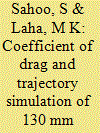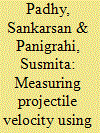| Srl | Item |
| 1 |
ID:
136038


|
|
|
|
|
| Summary/Abstract |
In the present study, the drag variation and trajectory elements estimation of a supersonic projectile having two different nose shapes are made numerically. The study aims at finding the coefficient of drag and shock wave pattern for 130 mm artillery shell fitted with recovery plug or with fuze, when travelling at zero angle of attack in a supersonic flow of air. The coefficient of drag (CD) obtained from the simulation is used as an input parameter for estimation of trajectory elements. The numerical results, i.e., the coefficient of drag at different Mach numbers and trajectory elements are validated with the data recorded by tracking radar from an experimental firing. Based on numerical results and data recorded in experimental firing, the coefficient of drag in the case of the shell with recovery plug is 2.7 times more than for the shell with fuze. The shock wave in the case of the shell with recovery plug is detached bow shock wave, whereas in the case of a shell with fuze, the shock is attached. The results indicate that the coefficient of drag increases with detached shock wave and an increase in the radius of the shell nose. Good agreements were observed between numerical results and experimental observations.
|
|
|
|
|
|
|
|
|
|
|
|
|
|
|
|
| 2 |
ID:
136037


|
|
|
|
|
| Summary/Abstract |
This paper deals with development of velocity measurement methodology based on projectile shock wave pressure measurements. The measurement principle is based on the fact that, whenever a projectile moves with supersonic velocity, shock wave fronts are produced along the trajectory of the projectile. Measurement configuration has been developed for measuring the shock wave pressure associated with projectile in flight, and hence, projectile velocity has been calculated. This paper covers various aspects of shock waves, generation of N Waves, feasibility study for capturing shock wave using dynamic microphone. Finally, suitable piezo-electric sensor has been selected and deployed in the trials and shock wave signature has been captured. From shock wave pressure, the projectile velocity has been computed.
|
|
|
|
|
|
|
|
|
|
|
|
|
|
|
|